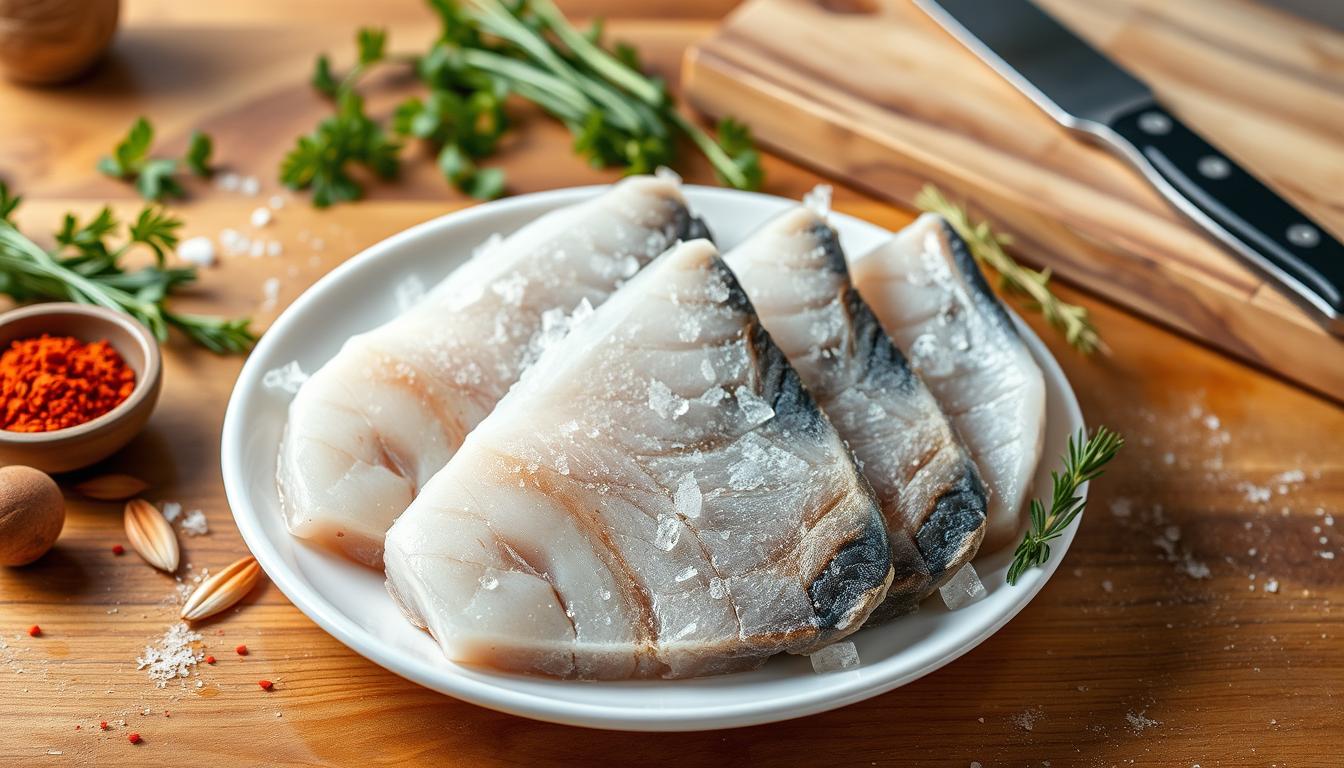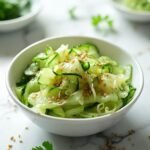As I reached into the freezer, I saw the familiar blue package of swordfish steaks. The thought of that rich, buttery flavor and meaty texture made my mouth water. But could I cook these frozen fillets and get the same delicious results as fresh ones?
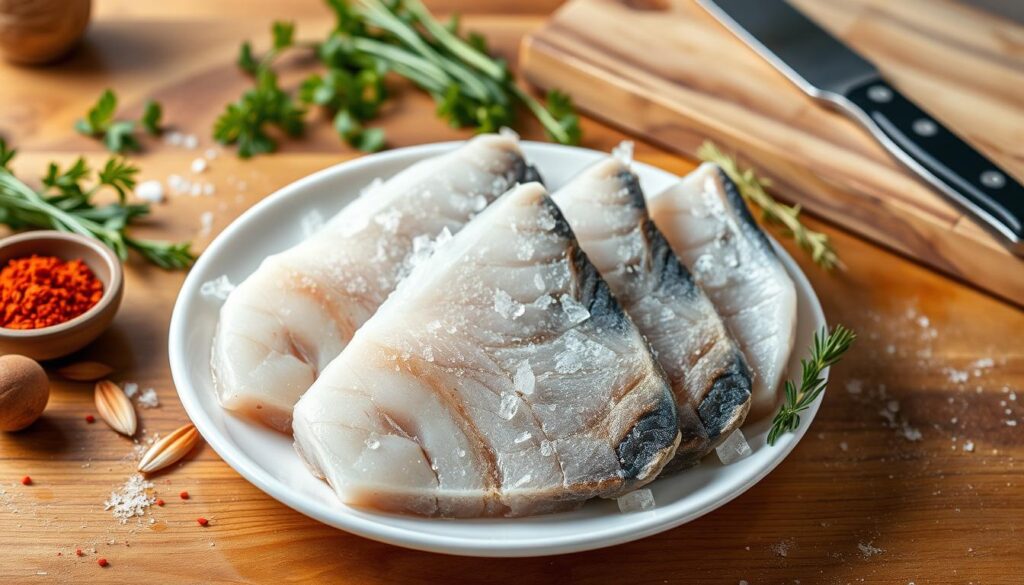
After some research, I found out that with the right techniques, frozen swordfish can be a game-changer in the kitchen.
Contrary to popular belief, cooking frozen swordfish is entirely possible. You just need to know a few tricks to ensure it turns out perfectly every time. This guide will walk you through the steps to mastering frozen swordfish and elevating your seafood game.
The Great Debate: Cooking Frozen Fish vs. Fresh
There’s a big debate about cooking fish with frozen versus fresh. Frozen fish is easy and affordable, but it needs special care to taste right. Fresh fish, on the other hand, tastes better and feels firmer in your mouth.
Exploring the Pros and Cons of Each Approach
Frozen fish is often frozen right after it’s caught, keeping its nutrients and taste. Most seafood we eat is imported, and a lot of it is frozen. Freezing fish quickly helps keep it fresh and full of nutrients.
Experts say fresh and frozen fish can be just as good if frozen properly. Frozen fish can also save money because you only use what you need. But, freezing can make some fish, like fluke, feel mushy.
To cook frozen fish well, pick the right types like farm-raised salmon. Make sure to wrap them tightly and freeze them for just a few months.
“Proper freezing and handling techniques ensure that textural quality is maintained, regardless of the fish’s fat content.”
Choosing between fresh and frozen fish depends on what you like, your recipes, and what’s available. While fresh fish is better, frozen fish is a good choice if done right.
Can I Cook Frozen Swordfish
Yes, you can cook frozen swordfish, but you need to make some changes. Frozen swordfish has more water, which can make it soggy and lose flavor. It’s key to thaw it first for the best taste and texture.
Choose baking, broiling, steaming, or poaching to cook frozen swordfish. These methods help get rid of extra moisture. Stay away from frying or pan-searing because it can make the fish soggy.
Fish like tilapia and cod work better when cooked from frozen. Swordfish, being fattier, can get soggy if not thawed and cooked right. For the best results, make sure to thaw it completely before cooking.
| Cooking Method | Recommended Cooking Time for Frozen Swordfish |
|---|---|
| Baking | 24 to 26 minutes at 450°F |
| Broiling | 5 to 6 minutes per side |
| Steaming | 6 to 10 minutes |
| Poaching | 8 to 12 minutes |
By following these tips and using the right cooking methods, you can make tasty meals with frozen swordfish. Always thaw the fish well before cooking for the best taste and texture.
“For stovetop dishes with fatty fish cooked from frozen, consider methods where the fish cooks in liquid with other ingredients.”
Choosing the Right Fish for Cooking from Frozen
Choosing the right fish for cooking from frozen is key. Lean fish varieties work best because they have less moisture. This makes them less likely to become soggy or watery when cooked.
Lean Varieties: The Best Candidates
Here are some top lean fish for cooking from frozen:
- Cod
- Tilapia
- Halibut
- Bass
- Grouper
These fish keep their texture and flavor well, even when frozen. Fattier fish like salmon and swordfish can be harder to cook. Their high moisture content can result in a less-than-ideal texture and taste.
For fatty fish like swordfish, use methods that help remove excess moisture. Baking, broiling, steaming, or poaching are good options.
| Fish Variety | Moisture Content | Recommended for Frozen Cooking |
|---|---|---|
| Cod | Low | Yes |
| Tilapia | Low | Yes |
| Halibut | Low | Yes |
| Salmon | High | No |
| Swordfish | High | No |
By picking the right lean fish and using the right cooking methods, you can make delicious meals from frozen fish.
Cooking Methods for Frozen Fish
When cooking frozen fish, some methods are better than others. Pan-searing or pan-frying is not recommended because it can make the fish soggy. Instead, use methods like baking, broiling, steaming, and poaching to evaporate excess moisture.
Baking and Broiling
Baking and broiling help the fish dry out, improving its texture and flavor. These methods are great for baking frozen fish and broiling frozen fish. They result in a delicious, evenly cooked dish.
Steaming and Poaching
Steaming frozen fish and poaching frozen fish are also good choices. They cook the fish gently, keeping its flavor and texture intact. These methods are perfect for preserving the natural taste and tenderness of the fish.
When cooking frozen fish, you might need to adjust the cooking time. The thicker texture and lower temperature of frozen fish can affect cooking time. It’s important to keep an eye on the fish and adjust the cooking time as needed to get it just right.
| Fish Variety | Baking Time (120-125°F) | Pan-Searing Time (120-130°F) | Steaming Time (120-130°F) |
|---|---|---|---|
| Coho or Sockeye Salmon | 24-26 minutes | 5-6 minutes + 2-3 minutes after flipping | 5-9 minutes |
| Pacific Halibut | 22-24 minutes | 4-5 minutes + 3-4 minutes after flipping | 6-10 minutes |
| Pacific Cod | 22-24 minutes | 3-4 minutes + 1-3 minutes after flipping | 6-10 minutes |
| Rockfish | 17-19 minutes | 2 minutes + 2-3 minutes after flipping | 2-6 minutes |
Always follow food safety guidelines and cook seafood to the right internal temperature. This ensures it’s safe to eat.
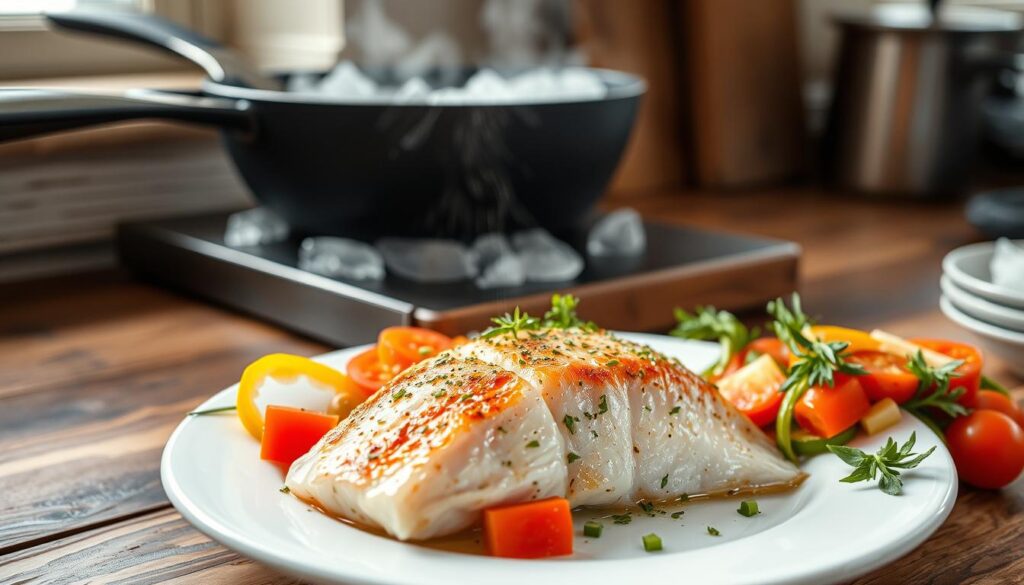
“Cooking fish straight from the freezer is possible and can be easier to avoid overcooking, ideal for inexperienced cooks.”
Preparing Frozen Fish for Cooking
To get the best results when preparing frozen fish for cooking, start by removing it from its packaging. Then, rinse it under cold water to get rid of ice crystals. After rinsing, thoroughly pat the fish dry with paper towels to remove excess moisture. This step is key for a nice brown color and to avoid a soggy texture.
For baking or broiling, lightly coat the fish with oil to improve texture and get that golden-brown sear. But don’t use too much oil, as it can make the fish taste greasy. By following these steps, your frozen fish will cook up flaky and delicious.
| Fish Variety | Baking/Broiling Time | Pan-Frying Time | Steaming Time |
|---|---|---|---|
| COHO or SOCKEYE | 24-26 minutes (120-125°F) | 5-6 minutes initial, 2-3 more after flipping | 5-9 minutes (120-125°F) |
| PACIFIC HALIBUT | 22-24 minutes (130°F) | 4-5 minutes initial, 3-4 more after flipping | 6-10 minutes (125-130°F) |
| PACIFIC COD | 22-24 minutes (130°F) | 3-4 minutes initial, 1-3 more after flipping | 6-10 minutes (130°F) |
| ROCKFISH | 17-19 minutes (130°F) | 2 minutes initial, 2-3 more after flipping | 2-6 minutes (130°F) |
Remember, the USDA says cooked swordfish should be at least 145°F (63°C). Proper preparation is essential for perfect frozen fish dishes every time.
Adjusting Cooking Times for Frozen Fish
Cooking frozen fish right is key to a great meal. It takes about 50% more time than thawed fish. This is because the frozen fish needs more time to heat up and cook evenly.
To check if your fish is cooked, use a meat thermometer. It should read 145°F (63°C). Also, thicker fish fillets need more cooking time than thin ones. Watching how the fish feels and looks as it cooks helps too.
Here are some tips for adjusting cooking times for frozen fish:
- Preheat your oven, air fryer, or other cooking equipment to the recommended temperature, typically around 400°F (200°C), before adding the frozen fish.
- Bake frozen fish for 15-20 minutes, or until it reaches the desired internal temperature.
- Air fry frozen fish for 10-15 minutes, flipping halfway through the cooking time.
- Pan-fry frozen fish for 5-7 minutes per side, using a small amount of oil to prevent sticking.
- Steam frozen fish for 10-15 minutes, or until it flakes easily with a fork.
With a bit of practice, you’ll get the cooking time just right for your frozen fish. Just remember to adjust the time based on the fish’s thickness. And always use a meat thermometer to make sure it’s cooked to 145°F (63°C).
| Cooking Method | Cooking Time for Frozen Fish |
|---|---|
| Oven Baking | 15-20 minutes |
| Air Frying | 10-15 minutes |
| Pan-Frying | 5-7 minutes per side |
| Steaming | 10-15 minutes |
Success with frozen fish cooking comes from adjusting cooking times and using a meat thermometer. This ensures the fish is cooked to a safe 145°F (63°C) inside.
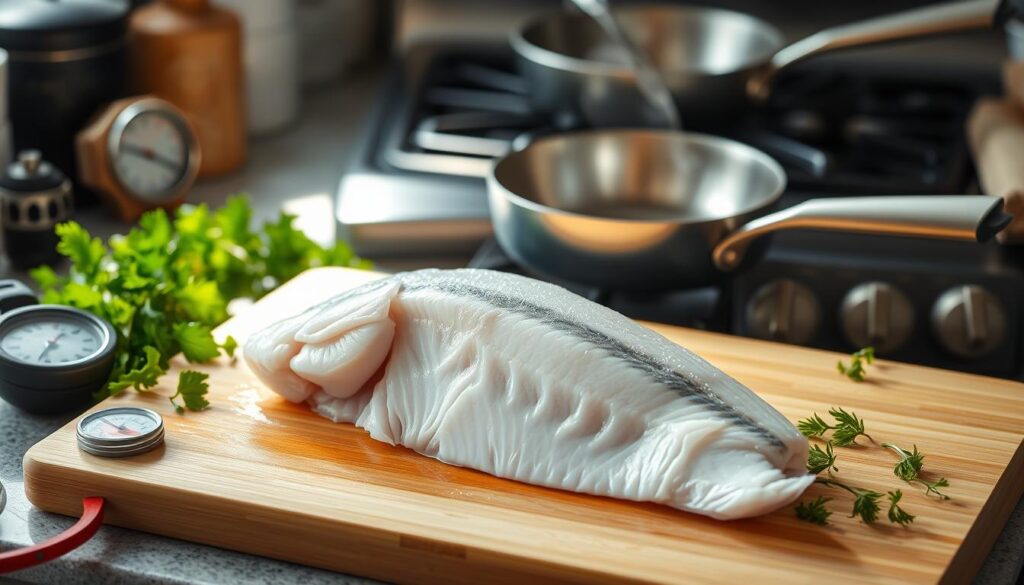
Recipes for Cooking Frozen Fish
Delicious Meal Ideas from Frozen
Frozen fish offers endless possibilities in the kitchen. It’s a convenient and versatile ingredient for many dishes. You can bake, pan-sear, or steam it to create tasty meals.
The Lemon Garlic Swordfish recipe is a favorite, with a 4.74 out of 5 rating from 303 users. It’s quick to prepare and cook, ready in just 20 minutes. It serves 4, providing about 241 calories per serving.
Swordfish steaks are also great for air fryer cooking. They cook in 10 minutes and must reach 145°F (63°C) for safety. Marinating them for 30 minutes to 8 hours adds flavor.
Choosing the right cooking method is key for frozen fish recipes. Baking, pan-searing, and steaming are all good options. Par-cooking and allowing for carryover cooking ensures the fish is perfectly cooked.
Easy frozen fish recipes are perfect for any meal. They’re quick, easy, and nutritious. With a bit of creativity, you can make frozen fish into a delicious dish.
Conclusion
Cooking frozen fish is easy and budget-friendly. But, you need to make some tweaks to get the best taste. Knowing how to cook cooking frozen fish and picking the right types can make your meals tasty and fulfilling.
When baking, broiling, steaming, or poaching frozen fish, it’s all about adjusting cooking times. Also, don’t overcrowd the pan. These steps help remove extra moisture. Soon, you’ll master cooking frozen fish recipes that are both flavorful and tender.
Always aim for an internal temperature of 145°F (63°C) for fully cooked fish. Cooking times can change based on the fish’s thickness and the method. By following these tips, you can make the most of frozen fish. This way, you’ll enjoy tasty meals with your loved ones.


